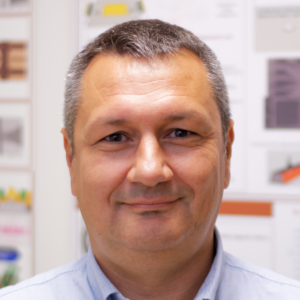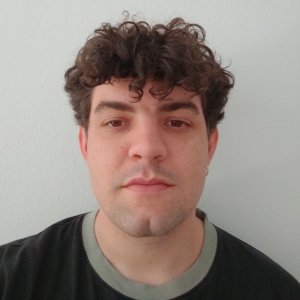Overview
The Magnetic Random Access Memories (MRAM) group develops advanced concepts in this emerging technology. The goal is to realize cells with improved thermal stability, lower power consumption and/or faster switching. Our research covers material stack deposition, nano-fabrication and electrical test evaluation, for applications as standalone memory and non-volatile logic and more recently in neuromorphic computing architectures.
Research directions
Perpendicular Anisotropy Materials
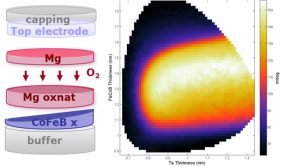
High energy barriers for spin transfer torque (STT) MRAM cells can be achieved with perpendicular anisotropy magnetic tunnel junctions. Solutions for high density MRAM cells to diameters below 20nm require continuous improvements in perpendicular surface anisotropy, while maintaining high TMR properties.
Perpendicular STT MRAM
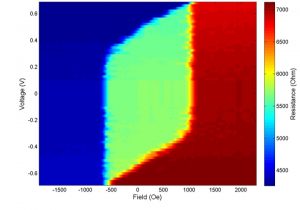
Evaluation of MRAM concepts requires simulation of expected reversal mechanisms and electrical characterization of individual cells. We aim at understanding dynamics of magnetization reversal and the expected impact of stack modifications to explore application specific optimizations.
Nanofabrication Challenges
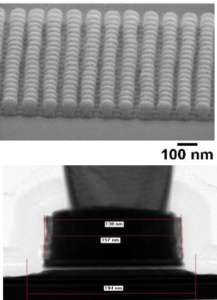
Innovation on dense MRAM using pre-patterned substrates, CMOS integration of multifunctional cells and sub-10nm lateral sizes. Tunnel junction nanofabrication in our platform is essential to evaluate MRAM concepts and performance.
Perpendicular Shape Anisotropy
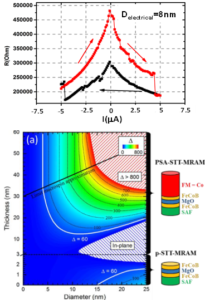
A solution for sub-10nm cell sizes uses high aspect ratios to generate perpendicular shape anisotropy providing scalable retention at the smallest cell sizes. Spin transfer torque switching is possible in these cells, where the reversal dynamics is now under study.
The team
Former members
Post-docs
- Andrey TIMOPHEEV (2014-2017)
- Van Dai NGUYEN (2016-2018)
- J. Ranier Roiz (2015-2016)
- Nikita Strelkov (2016-2019)
PhD
- Luc TILLIE (2015-2018)
- Nicolas PERRISSIN (2015-2018)
- Jyotirmoy CHATTERGEE (2014-2017)
- Hieu Tan NGUYEN (2013-2016)
- Antoine Chavent (2013-2015)
Process Engineers
- Jude GUELFFUCCI (2015-2017)
- Nathalie LAMARD (2016-2017)
- Guillaume LAVAITTE (2015-2016)
Projects
- Samsung SGMI (2014-2017)
- ANR Excalyb (2014-2017)
- Heumem (2015-2018)
- EU-FET Spice (2016-2019)
- EU Great (2016-2019)
- ERC Magical (2015-2020)
Partners
- CEA LETI, Grenoble, France
- Institut NEEL, Grenoble, France
- Crocus Technology, Grenoble, France
- Samsung, San Jose, USA
- Singulus AG, Kahl am Main, Germany
- Aarhus University, Aarhus, Denmark
- Radboud Universiteit, Neijmegen, Netherlands
Recent news
- 18 months post-doc position: pMTJs for memory and microwave devices (November 16th, 2016)
In the frame of our H2020 project GREAT we have one open position for a postdoc or term contract for 18 months to characterize the spin transfer torque induced magnetic switching as well as rf ... - SPINTEC’s spinoff HProbe offers 3D magnetic probers (November 03rd, 2016)
HProbe is the latest spin-off company from SPINTEC, based on our expertise in MRAM research at the wafer scale. HProbe offers a 3D magnetic field wafer-level electrical tester for all types of MRAM (STT, SOT, ... - Misalign to write faster (October 17th, 2016)
The writing in conventional magnetic memories based on magnetic tunnel junctions (STT-MRAM) is intrinsically stochastic : a large amplitude thermal fluctuation is required to trigger the siwthing of the storage layer magnetization. SPINTEC has shown ... - Editor – Proceedings of the IEEE, Special issue on Spintronics (October 01st, 2016)

Special issue on Spintronics, published in the proceedings of the IEEE, vol.104 (10), October 2016 Editors: Hideo Ohno, Mark Stiles, Bernard Dieny - Master students to visit SPINTEC and discuss our topics for internships (September 18th, 2016)
On 25th October 2016 our host Institut INAC welcomes students for a presentation of internship topics proposed to host Master-2 students during Spring 2017. Details will be provided later.







